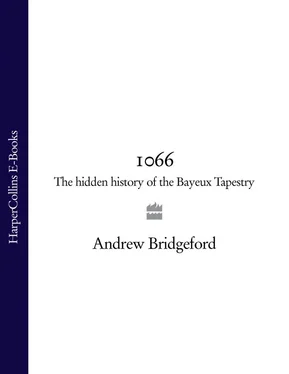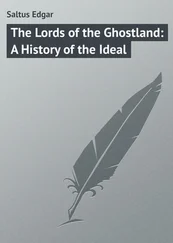You open the museum door, blinking as you enter. Inside it is quiet. You must buy a ticket. You follow a broad flight of stairs and then you emerge into a series of introductory rooms, like antechambers taking you step by step into the inner sanctum of a medieval mystery. At length you arrive in the longest of all the rooms, a long, windowless, narrow corridor with an unexpected bend in the middle. It is here that the Bayeux Tapestry is displayed, carefully illuminated in the darkness behind a thick glass case. It is stretched out in front of you like an enormous strip of film, a great colourful frieze of the Middle Ages, bright and lively, receding narrower and narrower into a dim and uncertain distance. Although barely half a metre wide, the work is astonishingly long, incredibly long for something that is so old and that ought to be so fragile that if you picked it up it might collapse into shreds. It runs for as far as can be seen along the wall of this narrow gallery, and then it rounds a bend and continues for as long again. It is, in total, about seventy metres in length; and it would have been perhaps ten metres longer had the final scenes not been lost at some distant point in the past. Even as it is, the surviving tapestry would outstretch Nelson’s Column by more than a third of its height.
The dramatic story of the Norman invasion of England in 1066 is set out in these threads, stitched by contemporaries and preserved and displayed here, in the very heart of victorious Normandy. Despite its great age and fragility, the work is uniquely well preserved. Most of what we see today is entirely original, and in those places where it has been repaired, the marks left by the original stitches seem, with certain exceptions, to have been followed with care, and such restorations as have been made to the tapestry do not generally interfere with the thrust of its interpretation. 1Embroidered on to a plain linen background in wools of red, yellow, grey, two greens and three shades of blue, the tapestry remains, against all expectation, as bright and captivating as if it had been made yesterday rather than nearly a thousand years ago. As you step along, the dimly lit gallery, the extraordinary story unfolds. The linen stage fills up quickly with busy figures, in castles and halls, on ships and on horseback, urgently looking here, pointing there, full of meaning, their voices straining through the centuries to tell us something secret and important. This is a medieval tale of intrigue, danger and war. It begins with the mysterious events that occurred a year or two before 1066 – the crucial background to what followed – before building to a climax with the events that made 1066 the most decisive year in English history. Amidst all the high drama, everyday details, recorded incidentally and without pretension by the artist, vividly bring his world to life: here some men are feasting on spitted birds; there they are drinking wine from ivory horns; others hunt, sow or go to church; men wade through the shallow water with their tunics hitched high or struggle, bent forward, to load heavy provisions on to a waiting ship. Each time you look, it seems that some further beguiling detail, previously missed, becomes apparent. The work is at once accessible and straightforward and yet at the same time deeply mysterious and arcane. A Latin commentary running along the top of the main frieze by turns illuminates and then infuriates us by its very terseness and ambiguity. Above and below the main frieze, two narrow borders are filled with strange designs: creatures, real and mythical, ancient fables drawn from Classical authors, astrological symbols, scenes of everyday life, the odd erotic incident.
Despite all the signs saying ‘Tapestry’ the Bayeux Tapestry is not a tapestry at all. It is, to be more accurate, an embroidery, for the images are stitched on to the fabric, rather than woven out of it in the true manner of tapestry-making. That said, the work is probably the most famous ‘tapestry’ in the world and it would be unnecessarily pedantic to insist on calling it anything else. It stands alone. We have no equivalent wall hanging from its time to hold up for comparison, nor do we have any document which describes when, why and by whom it was made. What can be known about the Bayeux Tapestry can only be deduced by historical detective work. Likewise, how it came to be in Bayeux, where it only appears in the surviving records in 1476, must be surmised, if at all, from evidence.
Even after you have seen the Bayeux Tapestry many times, the detail, length and complexity of the work remain astonishing and beguiling. Depicted along its length are 626 human figures, 202 horses, 55 dogs, 505 other animals, 49 trees, 37 buildings and 41 ships. It is a man’s tale: of 626 human figures only three in the main frieze, and two in the borders, are female. There are a few intriguing instances where the identity of a person, although not named, can be deciphered; but to identify individuals we are generally reliant on the running Latin inscription.
The inscription singles out by name a mere fifteen of the woollen actors; clearly, these are the key players in any quest to understand the true origin and meaning of the work. The named characters belong, for the most part, to the higher echelons of medieval society and they include famous men who would appear in any account of 1066; men such as Edward the Confessor, the old English king, and the two main rivals for his throne, Earl Harold of Wessex and Duke William of Normandy. In addition, however, four very obscure characters are also identified: a dwarf called Turold, depicted in the role of a groom [plate 1]; an English lady identified as Ælfgyva, seemingly embroiled in illicit liaison with a priest [plate 3]; and two minor Norman knights of no obvious significance, Wadard and Vital [plates 8 and 9]. The little dwarf, the elegant but scandalous lady and the two lesser-ranking Norman knights share the limelight with kings, dukes, counts, earls and bishops, teasing us to rediscover from other sources who they were and what strange significance they had in the artist’s vision of 1066. We must attempt to turn these curious characters into more rounded individuals. Amongst those who are better known is Bishop Odo of Bayeux [plate 10]. Odo was William’s greedy and ambitious half-brother. A key supporter of Duke William, he became, thanks to the Conquest, one of the richest men ever to have lived in England. Compared to other contemporary accounts, the Bayeux Tapestry gives Odo a surprising degree of prominence in the story of 1066. Studies of the tapestry have devoted much attention to the flattering way in which Bishop Odo is portrayed, but the focus on Odo has eclipsed the emphasis which is more subtly placed on others and it has obscured some of the more astonishing layers of hidden meaning in the work.
The popular conception of the Bayeux Tapestry is that it is a work of Norman triumphalism, of immense historical interest, no doubt, but ultimately a straightforward work produced by the Normans in order to celebrate and justify the conquest of England. Read any one of the many popular accounts and you will be told a similar story. It is said that we can see, in these threads, the childless English king, Edward the Confessor, near the end of his life, sending his foremost earl, Harold of Wessex, on a mission to Normandy; that Harold’s mission is to confirm to Edward’s distant cousin, Duke William of Normandy, that the old king has chosen him to be his heir; that after a misadventure in another part of France, from which Duke William obligingly rescues him, Earl Harold duly swears a solemn oath to be William’s man. Back in England, however, when Edward dies in January 1066, Harold treacherously seizes the throne for himself. Duke William has been cruelly wronged by the greedy Englishman and so he assembles a large Norman army and invades England in order to claim his rightful inheritance; and in the end, of course, he defeats the perfidious English at the Battle of Hastings (though not without a little help from his half-brother Odo) and Harold gets his come-uppance thanks to the famous arrow in the eye. The story is told ‘strictly from the Norman point of view.’ ‘It is all presented from a Norman perspective.’ ‘The story told in the tapestry is told from the Norman point of view.’ Such is the view of the Bayeux Tapestry reiterated time and time again in travel guides, brochures and popular history books.
Читать дальше











